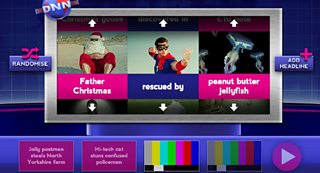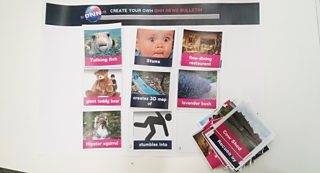A closer look at three CΒιΆΉΤΌΕΔ prototypes
Dan Cooper
Development Producer
Last year we developed and launched the three phase 2 Connected Studio prototypes. Robin Cramp introduced phase one of our three pilot projects in a last year. Now all three are being tested at scale after a second phase of development.
Here’s what we’ve learnt so far…
Mash Up by Young
The challenge: How to… to offer a compelling experience without the need for ?

We challenged the audience to create their own news bulletin.
Youngβs initial prototype Music Mash Up was a sandbox experience β letting children loop chunks of video and audio from CΒιΆΉΤΌΕΔ shows and sequence them together. User testing proved that the concept was too abstract, so we concentrated on tightly focussed audience challenges.
We wanted to find a model that could use the key tenets of the initial prototype: a fun interface, a creative challenge using fixed assets and an output with genuine value to the audience.
The result was a , a spoof-news show. We challenged the audience to create their own news bulletin.
We gave them 30 real-world, bizarre news headlines. We split each into three chunks β subject, verb and object β challenging kids to create comic combinations. Of which, 3,375 permutations are available. We created a handy spreadsheet to generate them all, meaning that we could comply all potential combinations in one fell swoop.
The experience went down really well with the audience. From early paper-prototyping sessions, we saw that children understood the model and enjoyed the challenge.

Paper prototypes
Their feedback helped us to understand, firstly, what kinds of headlines the audience were interested in; and secondly, how best to represent those for a diverse audience with a range of reading abilities and world knowledge. Interesting or funny looking pictures β especially those with animals and children in - led younger children. Older kids leant towards the weird and wonderful results of the combinations.
Our alpha build contained dummy images and a draft voice over with Bob and Felicity, the showβs news anchors. Kids assumed that pressing βplayβ would playback their bulletin, but were awestruck when they realised that the actual stars of the actual TV show were reading the actual daft news stories theyβd actually created. The βvalueβ of their handiwork was obvious; their instant reaction was to create another bulletin.
We published the game in May. We had a series of questions to answer and monitored stats and audience feedback throughout a 12-week live window to find out.
How attractive was the proposition to the audience?
95% of those accessing the game page went on to play it. Despite the assets / challenge remaining static, the game was played by roughly the same number of players per week as other games for similarly weighted brands β so the creative challenge wasnβt a turn-off!
Was the UGC challenge compelling, even with fixed assets?
We were interested to see where the drop-off was in usage of the game. Over 92% of users that created one headline, went on to create the maximum of four. Of those that created all four, 93% went on the view their creation. Nearly a quarter of users then immediately created another bulletin.
Did users feel compelled to share their creations?
Just short of 10% of users shared their creation β either by sending it in to CΒιΆΉΤΌΕΔ to be showcased online, or by sending to a friend. Both require an email address, a huge barrier for kids, so 1 in 10 is a significantly higher ratio than we expected. As a model for soliciting content from the audience, we usually get 10s or 100s of entries over similar time periods (landmark campaigns aside). This achieved just short of 10,000 during the trial window.
Weβre looking at the potential to create a template to offer this kind of experience regularly, at low-cost. This includes thinking about how it might work with regular editorial challenges and what the best value proposition for the audience might be, in terms of their creation. Is there an opportunity for them to create something for the TV screens? Weβve also commissioned a suite of grey-box engines that take the same approach to fun, tactile, templated creativity βΜύ try splatting some Dennis the Menace themed art or flinging choice facial features together in the Scooby Doo Monster Maker. This is the Lego end of the UGC market - giving children a set of parts with which to be creative with, rather than a blank sheet of paper.
Try making your own news bulletin and let me know what you think in the comments below.
Predicto Machino by Made by Pi
The challenge: How to⦠offer recommendations without the need for sign-in?
Sign-in is a big blocker for our audience. Parental consent is required for U16s and 90% of children accessing our sign-in page find this barrier insurmountable. Made by Pi created a prototype that served the audience with suggested games to play, based on their answers to a series of quirky questions, posed by CΒιΆΉΤΌΕΔ favourite Hacker T. Dog.
The game was nicely designed and fun, but the suggestions were ultimately arbitrary, so the audience wasnβt compelled to click through.

CΒιΆΉΤΌΕΔ favourite Hacker T. Dog
Phase 2 made the results compelling; filtering all available content via a set of questions that would ascertain interest in genres, content types and brands β resulting in a recommendation for a content item, be it a game, clip or an article.
Additionally, we wanted to keep the data fresh over time, crowd-source the intelligence behind the algorithm from audience patterns and make the game compliant with ΒιΆΉΤΌΕΔ web design principles ().
As a means to discover content, the game proved significantly less popular than our standard search bar. Around 10% of the number who ordinarily search for content on our site used Predicto Machino as an alternative method of content discovery.
However, those that did play the game were able to discover content they might not have ordinarily found in the website. The majority of the most popular recommendations were older, buried games.
Of those that did use , three-quarters clicked on the recommendation and went on to view/play/engage with it β thus, fulfilling the experience at small scale.
The patterns of the content they discovered also differed from the usual patterns on the site, perhaps because of the differing language used and context.
There are no plans to further develop this game, however the lessons learnt from it will feed into our longer-term conversations around personalisation and recommendations.
Get yourself a recommendation toβ this game is desktop only.
Inmate Inspection by Peekabu
The challenge: How might weβ¦ offer alternative ways to sign-in to Childrenβs services online?
This one launched more recently,Μύbut I can tell you what we intend to discover.
At CΒιΆΉΤΌΕΔ we want our audience to join in online, but we know itβs not always easy to allow them to do so in a safe way. Iβve already touched on the difficulties around sign-in for children, but there is a further hurdle. Once a user-name and password has been issued, remembering it and accurately entering it to log-in can be tricky, especially for those that donβt return to our site daily or weekly (or donβt always need to sign-in).
Eezl was identified as a potential way around this: the tech lets kids use hand-drawn (or indeed any other) images to sign in. The process doesnβt record the image itself, meaning no personal data is stored anywhere. Instead, it processes angle data from key points in the image β this provides a unique identifying key that can be easily recognized.

The tech lets kids use hand-drawn images to sign in
CΒιΆΉΤΌΕΔ wonβt do anything in this space without 100% safety assurance. The challenge for this prototype was to find a compelling way to test a number of things about the technology.
We commissioned Peekabu to make a game to test:
β’ Can we integrate the tech with ΒιΆΉΤΌΕΔ systems? The short answer is yes. The longer answer involves lots of paperwork and avoids our existing log-in and high-score systems.
β’ Does the audience understand the concept of drawing something in the real world to impact on a digital platform? User testing reactions were very encouraging. Testing at scale will be revealing to see how many kids have the right tools for the task β a webcam, something to draw with and something to draw on.
β’ If children use drawings, will they retain them for return visits? We chose a chaos management game structure, to encourage return visits as players get to nurture an environment over time. To meaningfully play the game, players have to use power ups. The power ups are registered as drawings (eg βStar powerβ) and impact on their game play. Kids can use any of their saved images to resume a game and re-draw any theyβve lost β but they need to retain at least one to pick up a saved game.
The game is desktop only. Grab a pen and paper and.
Many thanks to everyone that helped to get these pilots in front of an audience.
What we find outΜύfrom all three projects will help to define future strategy in ΒιΆΉΤΌΕΔ Childrenβs. Let me know what you think in the comments below.
Dan Cooper is a Development Producer in CΒιΆΉΤΌΕΔ Interactive
